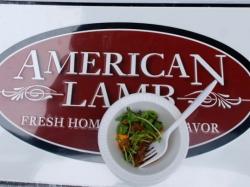American Lamb Board Unites New England Chefs At Boston Lamb Jam
March 19, 2010 | 2 min to read

DENVER — The American Lamb Board partnered with www.BostonChefs.com to bring
lambtastic dishes to the table at the first Boston American Lamb Jam on Sunday,
March 7, at the Charles Hotel in Cambridge, MA. Fifteen chefs competed for top
honors by creating succulent and savory selections paired with Boston beers and
hand-picked wines for the lamb loving public.
"This unique collaboration with BostonChefs.com gave us the opportunity to
celebrate American lamb with New England’s top culinary talent and showcase its
extraordinary versatility," said Megan Wortman, Executive Director, American
Lamb Board. "We were delighted to see the thoughtful creativity that went into
the construction of each dish." Guests at the American Lamb Jam enjoyed luscious
lamb tastes from competing chefs, and a panel of media judges awarded the
following "Best in Show" honors:
- Leg "Best in Show:" Gourmet Caterers for the Baked American Lamb Kibbeh
with Tahini Dressed Chickpea Salad, Tatziki, Pita and Basil - Loin "Best in Show:" Sel de la Terre for the Roasted American Lamb Loin
with Tart of Smoked Lamb, Baby Leeks, Crushed Peas and Meredith Farms
Marinated Feta with Carrot - Shank "Best in Show:" 606 Congress for the Crispy American Lamb Shank with
Mustard, Horseradish Aioli, Upland Cress, Pickled Radish - Shoulder "Best in Show:" Pain D’ Avignon for The Royale with Cheese –
Ground American Lamb Shoulder and Lamb Confit Burger with Mayflower Ale
Mustard and Crispy Onions
Fans of lamb additionally voted for a fifth "Best in Show" prize, which was
awarded to The Fireplace for their Braised American Lamb Shank on Chicopee
Wampanoag Porridge with Pomegranate Yogurt Cream (recipe below). A $1000
donation was made to the Brookline Community Mental Health Center, on behalf of
The Fireplace for their "Best in Show" honor.
For more information about the American Lamb Board and to view all of the
winning recipes from the Boston American Lamb Jam, please visit http://americanlamb.com.
You can follow the American Lamb Board on Facebook or Twitter, @FANofLAMB, to
keep up to date on news and events.
About the American Lamb Board
The American Lamb Board is an industry-funded research and promotions commodity
board that represents all sectors of the American Lamb industry including
producers, feeders, seed stock producers and processors. The Board, appointed by
the Secretary of Agriculture, is focused on increasing demand by promoting the
freshness, flavor, nutritional benefits, and culinary versatility of American
Lamb. The work of the American Lamb Board is overseen by the U.S. Department of
Agriculture and the board’s programs are supported and implemented by the staff
in Denver, Colorado.
For More Information About The American Lamb Board, Please Contact Marliese
Engel Traver (Mtraver@Baltzco.Com) At Baltz & Company – 212.982.8300
Source:
The American Lamb Board
